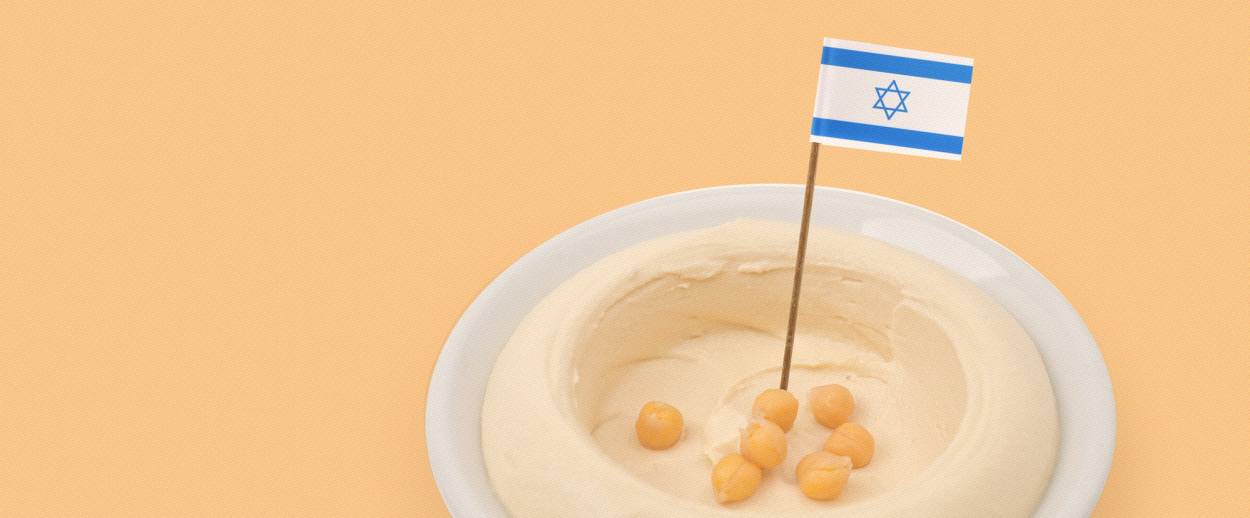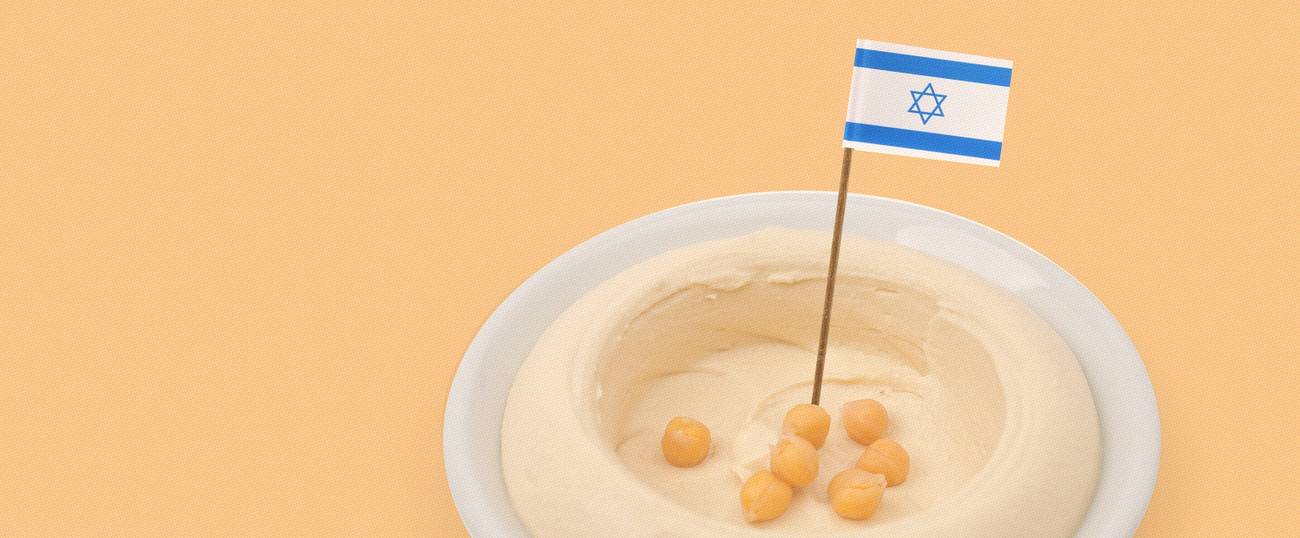Falafel Nation
Food helped unite Israel—and today also exposes divisions within the country, as Yael Raviv explains in her new book




Israeli expat Yael Raviv argues in her new book Falafel Nation that food has been an Israeli “marketing tool” since the initial wave of Zionist pioneers arrived more than a century ago. As Raviv illustrates with old postcards and other ephemera, members of that “First Aliyah” grew such “fruits of the land” as grapes and olives to forge “a more direct and powerful link with the land of Israel,” by literally putting down roots.
Despite its title, Falafel Nation—which explores the development of Israel’s culinary identity—is about much more than the much loved (and loathed) deep-fried chickpea balls. In fact, it might well have been titled Learning To Love Eggplant: Steeped in historical research yet eminently readable—the book is an outgrowth of Raviv’s PhD research; she now teaches Food Studies at New York University—the book outlines how Israelis became Israeli by embracing foods like the eggplant, a native food that was foreign to most early settlers.
Food has long played an important role in transmitting ideals and building a common culture in Israel. From the 1920s through the mid-20th century, locally produced agricultural products and commercial foods became major devices for Zionist or governmental propaganda. Through intensive marketing campaigns, ads, newspaper columns, and cookbooks, Raviv writes, women in particular were told that in a trip to the grocery store, “they held the power to influence the nation’s future.” This long campaign also included an intensive product labeling program that stamped items farmed by Jews as “Hebrew watermelon” or “Hebrew banana” or “Hebrew egg”—not merely locally produced, but produced “by Jewish hands.” In this way, everyday objects—here, foodstuffs—were transformed into national symbols. As Raviv explains, the campaign “drove the lesson home at every meal.”
The first cookbook for a Jewish audience in pre-state Israel was published in 1935. Sponsored by the Women’s International Zionist Organization, this cookbook had political underpinnings, Raviv writes, “once the Zionist movement realized that food could be a tool for transmitting national ideology.” Other cookbooks that followed also simultaneously attempted to unify the Jewish palate by deriding the “corrupt” eating habits of what we now call the Mizrachi diaspora while also introducing housewives (in German, English, or Hebrew) to ingredients such as olives and, yes, eggplant.
Throughout the mid-20th century, the young state actively tried to assimilate new immigrants from North Africa and the Middle East to Israel through cooking classes, hot lunch programs for children, and nutrition guides for middle-schoolers. Yishuv members and Zionist organizations, writes Raviv, “felt that the Socialist/European nature of the yishuv was in danger of levantinization.” Somehow the earlier settlers didn’t notice their geographic surroundings—that is, in the Levant—and instead they wanted these newer immigrants to stop being “Oriental” and cook “nutritious” and “modern” food like sandwiches.
Openness to cultural diversity in food only arrived in Israel in the 1960s, when a flurry of cookbooks followed the end of rationing in 1959. At this time the famous Israeli cookbook author Lillian Cornfeld divided her book Israeli Cookery into chapters according to ethnic origins or geographic regions including Bukharian, Kurdish, and Balkan. This period birthed the beginning of an Israeli trend of looking outward, reflected for example in Israeli cookbooks developed for American audiences, and by the 1980s, the first Chinese cookbook written in Hebrew.
But food continued to be used as an “instrument” of national unity in Israel. In the 1960s, El Al flight attendants wore bright orange uniforms with orange-shaped helmets as a sign of national pride—a reference to the Jaffa oranges that had become the country’s premier agricultural export, and, as Raviv writes, a powerful symbol “much like a flag.”
***
If food helped solidify Jewish nationalism in the country’s earlier decades, food is often at the center of more recent divisions within Israeli culture, though Raviv largely avoids any current debates. Where Israelis once looked for labels that identified which products had been produced “by Jewish hands,” today in Israel non-Jewish migrant workers from Asia, Africa, and Eastern Europe have upended what Raviv calls “the Zionist ethos of Hebrew (Jewish) labor.” It would be fascinating to hear more about this.
The Israeli pork industry similarly upends visions of Jewish nationalism. Raviv traces the mid-20th-century origins of pork products in Israel to Kibbutz Mizra, where pigs were initially raised. More recently the related company Ma’adaney Mizra has experienced a boom in profits thanks to products geared toward post-Soviet (i.e., post-kosher) immigrants, such as chicken “schnitzel” with a ham and cheese filling reminiscent of chicken cordon bleu.
Raviv includes a chapter on Israeli hotel cuisine, and the now famous Israeli hotel breakfast in particular. Here, too, food is tied up in notions of Diaspora and belonging. Hotel cuisine in Israel, as Raviv argues, gets to the heart of many issues of Israeli national identity: What counts as comfort food for tourists, when those tourists are mainly Jews looking in part for the exoticism of the Middle East but more largely a sense of belonging and home? In other words, should an Israeli hotel serve Cobb salad, gefilte fish, or falafel?
Raviv omits a larger discussion of Israeli restaurants, claiming that an exhaustive discussion of the Israeli restaurant scene is beyond the scope of the book. In truth, this topic deserves its own volume, but some sort of discussion would be welcome here, particularly to address issues like how non-specifically Israeli restaurants are changing the face of the national cuisine or how Israelis perceive what we call “new” Israeli cuisine in the Diaspora.
Raviv does include an interesting section on army cooks and army cuisine, including a discussion of the infamous luf, a kind of kosher Spam, and a history of the changing availabilities of foods to soldiers. Cuisine in the IDF improved as national security improved, another way we see the history of the nation through Raviv’s “prism of food.” She also includes a section on women’s historic military volunteer support by cooking in the otherwise mainly masculine job of fighting and protection.
Ultimately, Falafel Nation succeeds because it is not a story about food, full stop. It is the story of the building of a nation through food. For example, there is a section on cult favorite Israeli snack foods like Bamba and Crembo, grounded in research on nostalgia.
That said, there is one glaring and contentious absence: Israeli Arabs. In fairness, this book is about the building of the Jewish state and Jewish nationhood through food, and dishes with Arab roots like falafel do receive credit, but Israeli food culture more widely is deeply enmeshed with its neighbors and its own Arab citizens. This latter group represents one-fifth of the Israeli population, yet it has been excluded from this otherwise nuanced and unbiased discussion. If Israeli cuisine here is understood, like the nation, “as a process, as a changing, adaptable construct,” why is no Arab Israeli food really discussed beyond falafel?
Regarding falafel, by the way, Raviv gives brief but full credit to “Arab cooking,” while noting that Zionists gave the dish its iconic status as a “signifier of Israeli pride.” As she correctly notes, in this corner of the world, “a ground chickpea ball can be used as a weapon of sorts.” But how do Arab Israelis envision their own rich food culture in relation to Jewish Israeli national identity, and vice versa? Can we even draw a line between the two?
In her attempt to avoid controversy by grounding her work in theoretical models and solid research, Raviv has inadvertently, or at least implicitly, claimed a rather controversial stance by avoiding the subject of Israeli Arabs and their assumed “making of national identity in Israel,” as her subtitle suggests. What would Birthright Israel be, for example, without the obligatory stop to eat among the Druze? Does that not affect how Israeli food culture—and Jewish nationhood—is being created and disseminated? What about all the Israeli foodies (Jews and Arabs, and likely others) who worship at the hummus altar of Abu Hasan? Israeli food culture is not—and perhaps never has been—limited to Jewish food, whatever that is. Falafel Nation leaves us begging for more.
***
Like this article? Sign up for our Daily Digest to get Tablet Magazine’s new content in your inbox each morning.
Lara Rabinovitch received her PhD from New York University in 2012 and is a specialist in food culture and history. She currently lives in Los Angeles, where she is a writer and producer.